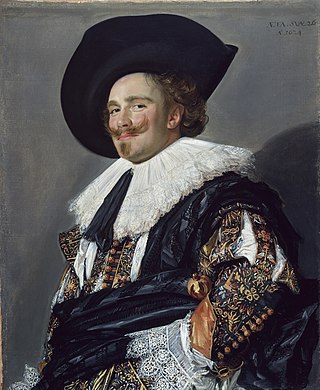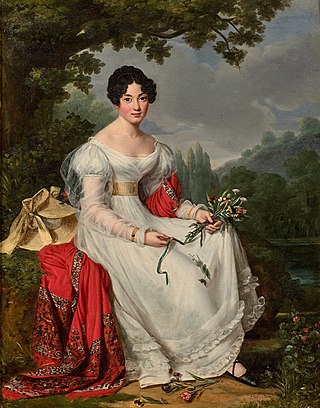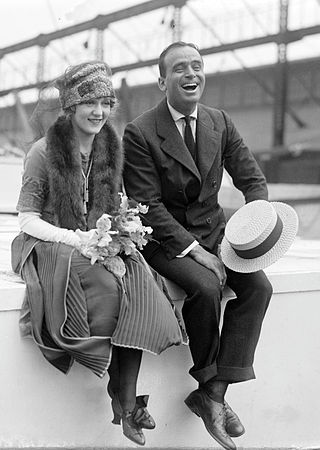Related Research Articles

The history of dance is difficult to access because dance does not often leave behind clearly identifiable physical artifacts that last over millennia, such as stone tools, hunting implements or cave paintings. It is not possible to identify with exact precision when dance becomes part of human culture. Dance is filled with aesthetic values, making it distinct from one society to another and is shrouded in symbolism that expounds on the cultural heritage of a community accordingly being unique from one society to another. Dance can help tell a story, convey feelings and emotions, and connect with others and ourselves.

A kurta is a loose collarless shirt or tunic worn in many regions of South Asia, and now also worn around the world. Tracing its roots to Central Asian nomadic tunics, or upper body garments, of the late-ancient- or early-medieval era, the kurta has evolved stylistically over the centuries, especially in and around the Indian subcontinent, as a garment for everyday wear as well as for formal occasions.

A chādor, also variously spelled in English as chadah, chad(d)ar, chader, chud(d)ah, chadur, and naturalized as, is an outer garment or open cloak worn by many women in the Persian-influenced countries of Iran, Afghanistan, Pakistan, and to a lesser extent Tajikistan, as well as in Shia communities in Iraq, Bahrain, and Qatif in Saudi Arabia in public spaces or outdoors. A chador is a full-body-length semicircle of fabric that is open down the front. The garment is pulled over the head, and is held closed at the front by the wearer; the chador has no hand openings, buttons, or clasps. It may also be held closed by being tucked under the wearer's arms. The word in classical Persian could be used in reference to almost any cloth, headscarf, or even tents. This definition is mostly retained in eastern dialects of Persian which commonly use chādar in reference to almost any cloth or scarf, including loosely worn scarves that would be inappropriate to call a chador in Iranian Persian.

1860s fashion in European and European-influenced countries is characterized by extremely full-skirted women's fashions relying on crinolines and hoops and the emergence of "alternative fashions" under the influence of the Artistic Dress movement.

1870s fashion in European and European-influenced clothing is characterized by a gradual return to a narrow silhouette after the full-skirted fashions of the 1850s and 1860s.

An evening gown, evening dress or gown is a long dress usually worn at formal occasions. The drop ranges from ballerina, tea, to full-length. Such gowns are typically worn with evening gloves. Evening gowns are usually made of luxurious fabrics such as chiffon, velvet, satin, or organza. Silk is a popular fibre for many evening gowns. Although the terms are used interchangeably, ball gowns and evening gowns differ in that a ball gown will always have a full skirt and a fitted bodice, while an evening gown can be any silhouette—sheath, mermaid, fit and flare, A-line, or trumpet-shaped—and may have straps, halters or even sleeves.

Byzantine dress changed considerably over the thousand years of the Empire, but was essentially conservative. Popularly, Byzantine dress remained attached to its classical Greek roots with most changes and different styles being evidenced in the upper strata of Byzantine society always with a touch of the Hellenic environment. The Byzantines liked colour and pattern, and made and exported very richly patterned cloth, especially Byzantine silk, woven and embroidered for the upper classes, and resist-dyed and printed for the lower. A different border or trimming round the edges was very common, and many single stripes down the body or around the upper arm are seen, often denoting class or rank. Taste for the middle and upper classes followed the latest fashions at the Imperial Court.

Fashion in the period 1550–1600 in European clothing was characterized by increased opulence. Contrasting fabrics, slashes, embroidery, applied trims, and other forms of surface ornamentation remained prominent. The wide silhouette, conical for women with breadth at the hips and broadly square for men with width at the shoulders had reached its peak in the 1530s, and by mid-century a tall, narrow line with a V-lined waist was back in fashion. Sleeves and women's skirts then began to widen again, with emphasis at the shoulder that would continue into the next century. The characteristic garment of the period was the ruff, which began as a modest ruffle attached to the neckband of a shirt or smock and grew into a separate garment of fine linen, trimmed with lace, cutwork or embroidery, and shaped into crisp, precise folds with starch and heated irons.

Fashion in the years 1750–1775 in European countries and the colonial Americas was characterised by greater abundance, elaboration and intricacy in clothing designs, loved by the Rococo artistic trends of the period. The French and English styles of fashion were very different from one another. French style was defined by elaborate court dress, colourful and rich in decoration, worn by such iconic fashion figures as Marie Antoinette.

Fashion in the period 1600–1650 in Western clothing is characterized by the disappearance of the ruff in favour of broad lace or linen collars. Waistlines rose through the period for both men and women. Other notable fashions included full, slashed sleeves and tall or broad hats with brims. For men, hose disappeared in favour of breeches.

During the 1820s in European and European-influenced countries, fashionable women's clothing styles transitioned away from the classically influenced "Empire"/"Regency" styles of c. 1795–1820 and re-adopted elements that had been characteristic of most of the 18th century, such as full skirts and clearly visible corseting of the natural waist.

Fashion in the period 1650–1700 in Western clothing is characterized by rapid change. The style of this era is known as Baroque. Following the end of the Thirty Years' War and the Restoration of England's Charles II, military influences in men's clothing were replaced by a brief period of decorative exuberance which then sobered into the coat, waistcoat and breeches costume that would reign for the next century and a half. In the normal cycle of fashion, the broad, high-waisted silhouette of the previous period was replaced by a long, lean line with a low waist for both men and women. This period also marked the rise of the periwig as an essential item of men's fashion.

Fashion in the period 1795–1820 in European and European-influenced countries saw the final triumph of undress or informal styles over the brocades, lace, periwigs and powder of the earlier 18th century. In the aftermath of the French Revolution, no one wanted to appear to be a member of the French aristocracy, and people began using clothing more as a form of individual expression of the true self than as a pure indication of social status. As a result, the shifts that occurred in fashion at the turn of the 19th century granted the opportunity to present new public identities that also provided insights into their private selves. Katherine Aaslestad indicates how "fashion, embodying new social values, emerged as a key site of confrontation between tradition and change."

Fashion in the period 1700–1750 in European and European-influenced countries is characterized by a widening silhouette for both men and women following the tall, narrow look of the 1680s and 90s. This era is defined as late Baroque/Rococo style. The new fashion trends introduced during this era had a greater impact on society, affecting not only royalty and aristocrats, but also middle and even lower classes. Clothing during this time can be characterized by soft pastels, light, airy, and asymmetrical designs, and playful styles. Wigs remained essential for men and women of substance, and were often white; natural hair was powdered to achieve the fashionable look. The costume of the eighteenth century, if lacking in the refinement and grace of earlier times, was distinctly quaint and picturesque.

Western fashion in the 1920s underwent a modernization. For women, fashion had continued to change away from the extravagant and restrictive styles of the Victorian and Edwardian periods, and towards looser clothing which revealed more of the arms and legs, that had begun at least a decade prior with the rising of hemlines to the ankle and the movement from the S-bend corset to the columnar silhouette of the 1910s. Men also began to wear less formal daily attire and athletic clothing or 'Sportswear' became a part of mainstream fashion for the first time. The 1920s are characterized by two distinct periods of fashion: in the early part of the decade, change was slower, and there was more reluctance to wear the new, revealing popular styles. From 1925, the public more passionately embraced the styles now typically associated with the Roaring Twenties. These styles continued to characterize fashion until the worldwide depression worsened in 1931.

Pakaian is the term for clothing in Malaysia's national language. It is referring to things to wear such as shirts, pants, shoes etc. Since Malaysia is a multicultural nation: Malay, Chinese, Indian and hundreds of other indigenous groups of Malay peninsula and Borneo, each has its own traditional and religious articles of clothing all of which are gender-specific and may be adapted to local influences and conditions. Previously, traditional clothes were worn daily. However, by excluding Baju Melayu, Baju Kurung many are now only worn on special occasions such as marriage ceremonies and cultural events.

Fashion from 1910 to 1919 in the Western world was characterized by a rich and exotic opulence in the first half of the decade in contrast with the somber practicality of garments worn during the Great War. Men's trousers were worn cuffed to ankle-length and creased. Skirts rose from floor length to well above the ankle, women began to bob their hair, and the stage was set for the radical new fashions associated with the Jazz Age of the 1920s.

Croatian national costume, also called as Croatian traditional clothing or Croatian dress, refers to the traditional clothing worn by Croats living in Croatia, Bosnia and Herzegovina, Serbia, with smaller communities in Hungary, Austria, Montenegro, and Romania. Since today Croats wear Western-style clothing on a daily basis, the national costumes are most often worn with connection to special events and celebrations, mostly at ethnic festivals, religious holidays, weddings, and by dancing groups who dance the traditional Croatian kolo, or circle dance.

Fashion in the twenty years between 1775 and 1795 in Western culture became simpler and less elaborate. These changes were a result of emerging modern ideals of selfhood, the declining fashionability of highly elaborate Rococo styles, and the widespread embrace of the rationalistic or "classical" ideals of Enlightenment philosophes.

Mughal clothing refers to clothing adhered by the Mughals in the 16th, 17th and 18th centuries throughout the extent of their empire. Much of them were already being used in the past centuries before their arrival in Indian subcontinent. It was characterized by luxurious styles and was made with muslin, silk, velvet and brocade. Elaborate patterns including dots, checks, and waves were used with colors from various dyes including cochineal, sulfate of iron, sulfate of copper and sulfate of antimony were used.
References
- ↑ "Persian Dance" . Retrieved 2007-06-19.[ permanent dead link ]